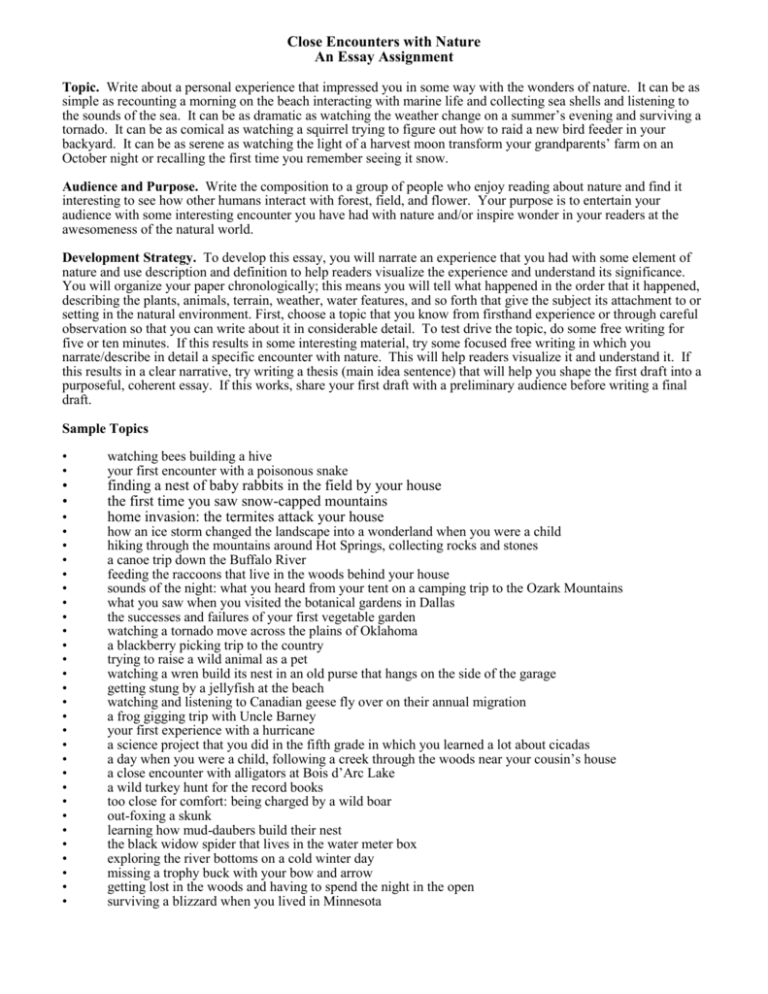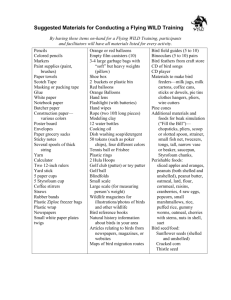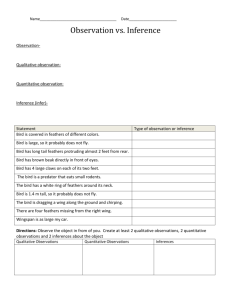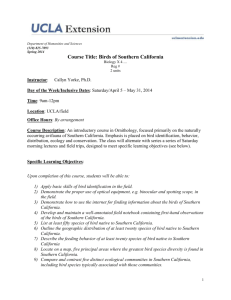Close Encounters with Nature An Essay Assignment • finding a nest
advertisement

Close Encounters with Nature An Essay Assignment Topic. Write about a personal experience that impressed you in some way with the wonders of nature. It can be as simple as recounting a morning on the beach interacting with marine life and collecting sea shells and listening to the sounds of the sea. It can be as dramatic as watching the weather change on a summer’s evening and surviving a tornado. It can be as comical as watching a squirrel trying to figure out how to raid a new bird feeder in your backyard. It can be as serene as watching the light of a harvest moon transform your grandparents’ farm on an October night or recalling the first time you remember seeing it snow. Audience and Purpose. Write the composition to a group of people who enjoy reading about nature and find it interesting to see how other humans interact with forest, field, and flower. Your purpose is to entertain your audience with some interesting encounter you have had with nature and/or inspire wonder in your readers at the awesomeness of the natural world. Development Strategy. To develop this essay, you will narrate an experience that you had with some element of nature and use description and definition to help readers visualize the experience and understand its significance. You will organize your paper chronologically; this means you will tell what happened in the order that it happened, describing the plants, animals, terrain, weather, water features, and so forth that give the subject its attachment to or setting in the natural environment. First, choose a topic that you know from firsthand experience or through careful observation so that you can write about it in considerable detail. To test drive the topic, do some free writing for five or ten minutes. If this results in some interesting material, try some focused free writing in which you narrate/describe in detail a specific encounter with nature. This will help readers visualize it and understand it. If this results in a clear narrative, try writing a thesis (main idea sentence) that will help you shape the first draft into a purposeful, coherent essay. If this works, share your first draft with a preliminary audience before writing a final draft. Sample Topics • • • • • • • • • • • • • • • • • • • • • • • • • • • • • • • • watching bees building a hive your first encounter with a poisonous snake finding a nest of baby rabbits in the field by your house the first time you saw snow-capped mountains home invasion: the termites attack your house how an ice storm changed the landscape into a wonderland when you were a child hiking through the mountains around Hot Springs, collecting rocks and stones a canoe trip down the Buffalo River feeding the raccoons that live in the woods behind your house sounds of the night: what you heard from your tent on a camping trip to the Ozark Mountains what you saw when you visited the botanical gardens in Dallas the successes and failures of your first vegetable garden watching a tornado move across the plains of Oklahoma a blackberry picking trip to the country trying to raise a wild animal as a pet watching a wren build its nest in an old purse that hangs on the side of the garage getting stung by a jellyfish at the beach watching and listening to Canadian geese fly over on their annual migration a frog gigging trip with Uncle Barney your first experience with a hurricane a science project that you did in the fifth grade in which you learned a lot about cicadas a day when you were a child, following a creek through the woods near your cousin’s house a close encounter with alligators at Bois d’Arc Lake a wild turkey hunt for the record books too close for comfort: being charged by a wild boar out-foxing a skunk learning how mud-daubers build their nest the black widow spider that lives in the water meter box exploring the river bottoms on a cold winter day missing a trophy buck with your bow and arrow getting lost in the woods and having to spend the night in the open surviving a blizzard when you lived in Minnesota Sample Thesis Statements 1. 2. 3. 4. 5. Sometimes the best fishing trip is the one that allows you to enjoy the sights and sounds of nature, even though the fish aren’t biting. My encounter with a brown bear while deer hunting in the woods of south Arkansas taught me a healthy respect for nature. Planting and tending a flower garden is the most therapeutic activity for people who have a tough job that drains them of energy, inspiration, and the will to live. Building a pond with a waterfall is an invitation to wildlife to come and enjoy your backyard with you. There are too many different plants and animals on Earth for any one person to learn them all in a lifetime. Sample Essay Mitch Donaldson Ms. Connolly English III 12 March 2005 New Birds on the Block One of the great pleasures of living on Earth is enjoying the great diversity of animal and plant life. So many different kinds of flora and fauna populate this planet that it’s difficult to become familiar with even a fraction of those that live in one’s own neighborhood. However, sometimes I am foolish enough to think that I have seen every plant and critter that lives in or wanders through south central Arkansas, where I call home. This kind of smugness is soon dispelled when I see a wildflower or an insect I had never noticed. In short, there are too many different plants and animals on Earth for any one person to learn them all in a lifetime. Last spring I was sitting on the back porch, reading a book and enjoying a glass of ice tea. It was the beginning of a pleasant day in June before the harsh humidity of mid-summer had set in and after the cold breezes of winter were gone for another year. Suddenly, I noticed a faint twittering sound in the althea tree about ten feet away. Looking up, I saw what appeared to be a miniature mocking bird perched on one of the upper branches. It was a charming little fellow with blue-gray feathers on its wings and back, a white breast, and a noticeable white ring around each of its black eyes. The coloration on the wings was a bit darker than on its head and back and became so dark on the tail feathers that they looked virtually black. Edged in white, these dark tail feathers were as long as the rest of his body. Unlike the mocking bird that it resembled, its song-bird repertoire was much more limited and the volume much quieter than the average loud-mouthed mocking bird that can string together a dozen different melodies in short order. Anyway, this mystery bird was eyeing a black bug that was innocently minding its own business on a white althea blossom. The bug, a small beetle, had not really put itself in danger of becoming another creature’s breakfast until it crawled out of the dark purple center of the flower where it had apparently been feeding on nectar. Before I could blink three times, another bird of the same type had swooped down from an upper branch where it had been hidden from my view by the overhang on the back porch and grabbed that bug in his small, black beak. This audacious theft set off a brief battle between the two birds and created a blur of blue and white feathers rising and falling in mid-air as they struggled for ownership of this breakfast bug. Unaware of my presence only feet away, these innocent-looking little creatures showed me how fierce they could become when food was at stake, not unlike human beings behave when the last doughnut lies invitingly on the plate. At this point in the little drama, my cell phone rang; and the two unidentified birds disappeared. When I finished talking to my friend, I made a beeline to the bookcase in search of a copy of the Audubon Field Guide to North American Birds. Thumbing through the perching bird section, I spotted a photograph of a bird just like the ones I had observed in the back yard. Beside the photograph was the name of the species, the blue-gray gnatcatcher. The book said that these birds mostly live in southern Canada and the northern United States but that they sometimes stray into the southern states. I was surprised. I have lived in Arkansas all my life, and I have never noticed any blue-gray gnatcatchers. I thought I had seen every bird that ever ventures this far south, so I was unprepared for these new birds on the block. They reminded me that the world teems with life and that the rich diversity of plants and animals with which we share the soil, the air, and the sea make living here an adventure and give us a sense of discovery if we’re willing to open our eyes.






